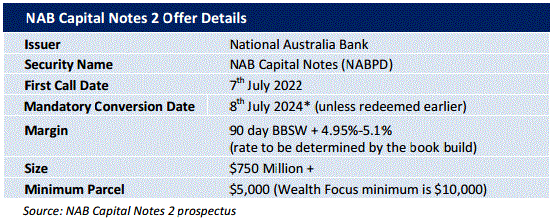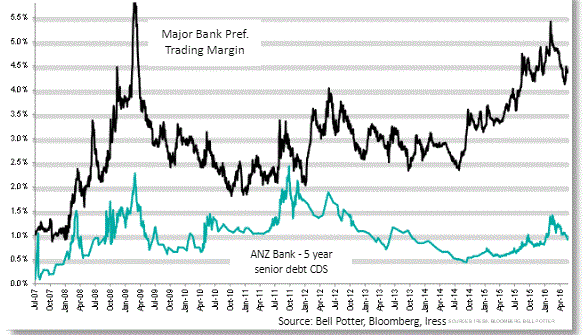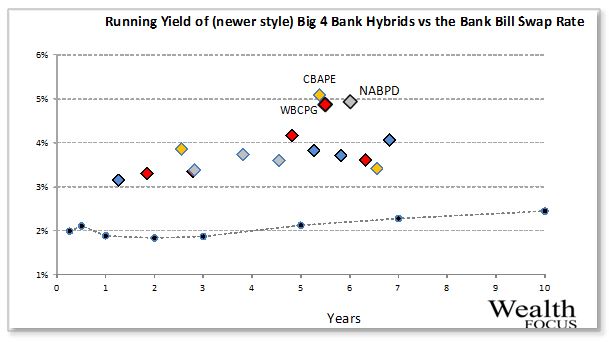NAB has just announced the launch of a new income offer: NAB Capital Notes. The first round of access is through a broker firm allocation, prior to shareholder and general offer and listing in July.
The Notes will pay a quarterly coupon of 4.95%-5.1% (margin determined by the book build) over the 90 day bank bill swap rate (BBSW), which was 1.99% as of 31st May. The initial indicative rate will be 6.94%-7.09%pa with the rate to be set on the date of issue. The Notes are expected to redeem on the 7th July 2022* and will be tradable on the ASX under code NABPD.

* It is expected that the issue will be repaid at the first opportunity in July 2022 with a scheduled conversion in 2024 (subject to mandatory conditions not being breached).
Hybrids
We have covered the features of fixed income hybrids on numerous occasions over the previous two years. Investors who are looking for a basic understanding of hybrids and differentiating products can watch our online video An Introduction to Fixed Income.
Our analysis
NAB’s new issue, and previous hybrids from Westpac (WBCPG) and CBA (CBAPE), are offering Investors a healthy margin over the 90 Day Bank Bill Rate (BBSW) as Investors demand higher returns.
The closest comparables to NABPD are CBA’s recent issue, Perls 8 (CBAPE), and Westpac Capital Notes 4 (WBCPG), both expected to be repaid in 2021.
Pricing – Yield to Maturity in the secondary market
Looking at the secondary market, NAB looks to have priced Capital Notes 2 in line with other hybrids with the added attraction of a higher running yield.
Higher Running Yield
Investors should note the difference between Running Yield (distributions divided by purchase price) and the Yield to Maturity which accounts for the capital gain/loss in holding the hybrid to anticipated repayment.
During times of distress, hybrids offering higher running yields have historically traded at a premium to alternative (lower margin) securities as investors move their focus to the ongoing income and should therefore command a premium over their lower yielding comparables.
Non-viability Clause, Capital Trigger Event and Inability Event
Investors who are familiar with the new style hybrids we have seen over the last couple of years will be very aware of these clauses.
It is useful to understand that these clauses are as a result of APRA requiring further reassurance that in another GFC event, if required, hybrids would convert to ordinary equity, thereby reducing the bank’s debt costs and protecting deposit holders.
Now that banks have to hold a higher level of capital and a better quality loan book, it seems unlikely that any of these conditions would be breached, however, investors would do well to consider the increased disclosure and warnings within each prospectus over the last couple of years.
For those unfamiliar with the conditions, new hybrids now contain non-viability and capital trigger clauses that should the bank’s Tier 1 Capital Ratio fall below 5.125%, or APRA views the bank as non-viable without an injection of capital, the hybrids would automatically convert to ordinary shares.
We have also seen a gradual introduction of an Inability Event Clause added which states that in the event that the issuer is unable to issue further ordinary shares, ie the company has ceased trading, a Capital Trigger Event or Non-Viability Event, hybrid note holders lose their investment.
This is extremely unlikely however Investors would do well to remember that, an increase in yield often carries additional risk.
Our View on NAB Capital Notes 2
We maintain our concerns over the non-viability clauses within the new style of hybrids but with spreads providing better returns to Investors, it is our view that these investments are relatively attractive for Investors looking to reduce their overall exposure to equities whilst still targeting an high yield. We do not consider hybrids a suitable alternative for fixed income/cash as it behaves differently during periods of financial market distress.
We anticipate this year’s relatively high issue margins of 4.9%-5.2% over BBSW will be very attractive to retail Investors and command a premium to the lower margin alternatives. As a result, it is our view that although NAB Capital Notes 2 has been priced in line with the secondary market, we would expect to see this trading at a premium upon listing.
For Investors looking for a view relative to Westpac Capital Notes 4, it is our view that both issues currently offer value and are well priced relative to the market with Westpac’s Capital Notes 4 marginally retaining the upper hand as NAB hybrids have historically traded at a wider premium in addition to the slightly longer duration of 6 years.
Contact us if you would like an allocation to NAB Capital Notes 2.
Key features
- Indicative floating yield of 6.94%-7.09%pa – based on current 90 BBSW of 1.99% and book build margin range of 4.95-5.1%.
- Option to redeem at year 6 with scheduled conversion at year 8 – NAB has the option to convert/redeem in July 2022 or on any subsequent dividend payment date.
- Ordinary dividend restrictions – applies on the non-payment of NABPD distributions
- Automatic conversion under the Capital Trigger Event and Non-Viability
- Redemption highly likely in 6 years – although NABPD has an 8 year mandatory conversion, it is likely NAB will redeem/convert at the first call date in July 2022. Major incentives for redemption/conversion include the potential for reputational damage, leading to a likely increased cost of funding on future debt issues.
Note: NAB Capital Notes 2 will be listed on the ASX and as such the price of the Notes will be subject to market movements. Investors selling on market may receive a price lower (or higher) than the issue price.
Investors looking for an allocation can contact us on 1300 559 869
We encourage you to view our online presentation An Introduction to Fixed Income




Comment: